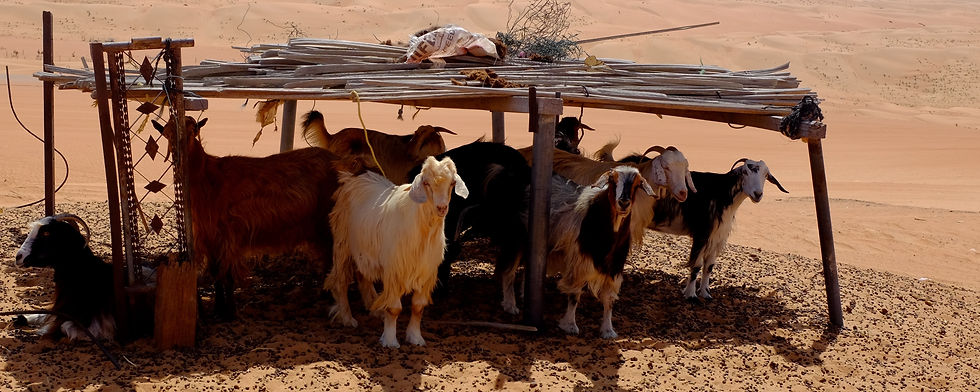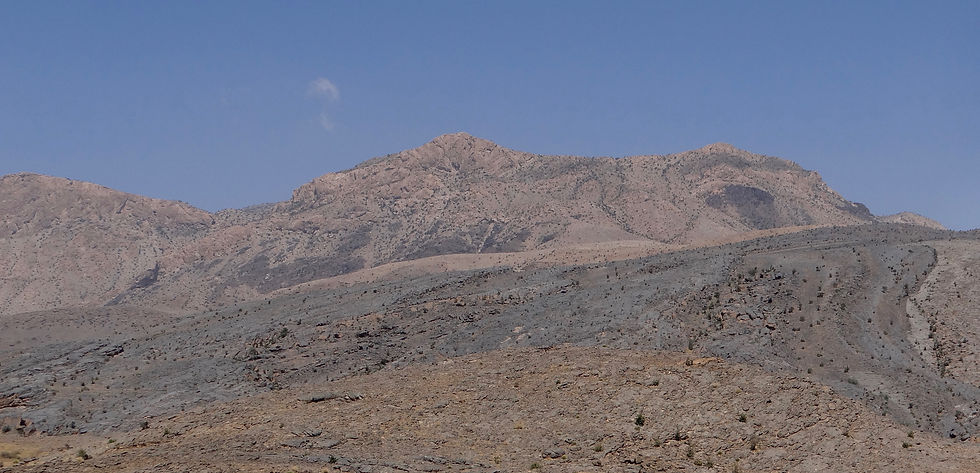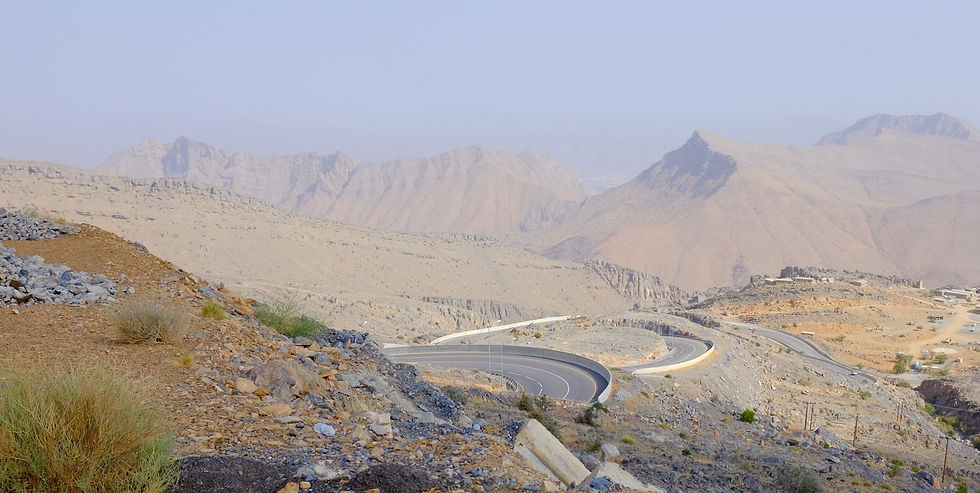#18 from desert to mountains
- Shelley Dark

- Oct 17, 2016
- 8 min read

We slept very well in our desert tent, dreaming of Lawrence of Arabia or breakfast, and were up early to take a few photographs before the sun was too high.

Overnight all footprints had been erased as if they'd never been there, and little rills had been reformed in the sand.

Guests had an included option of going for a camel ride after breakfast. The Bedouin tannaf (camel driver) had arrived early and his camels were saddled, sitting patiently. Doesn't she look just so pretty and agreeable? She couldn't fool me. I went on a (wide) camel ride in Morocco and was nearly split from stem to stern as I slipped further and further down the rump. I knew from that experience that I'd rather poke myself in the eye with a stick. But they're such beautiful subjects for photography.

Oh what big teeth you have!

Their keeper had pretty nice teeth too! He was sitting in the full sun, waiting patiently, his scarf casually draped over his head.

His goodies were spread out on his rug. Water, pencil, money, phone, sandals. The essentials.

We had our breakfast outside the dining room in the shade.

Our omelette was cooked by our Sri Lankan chef.

Ali was ready for us, looking smart in his white dishdasha. Men take 5 or 6 to the laundry at a time and they cost .2 rial each - Ali says you need to choose your laundry well to make sure your whites stay white. Usually it's next door to barber and coffee shop so while they're there they often have their beard trimmed.

Such a sensible choice for a potted plant in the desert.

Luggage loaded, we set off for Bideyah en route to a Bedouin camp. I like the soft ride on the sand as the vehicle gently skids from side to side.

Ali screeched to a halt (in a manner of speaking) so we could take the camels.

When we got out, one of the smallest local workers was out on the job already. A dung beetle, carrying a piece of poo bigger than himself, rolling it over and over. What a work ethic!

Bye bye Desert Nights. It's been great.
The house we were to visit was once the main house of this Bedouin family, but these days most Bedouins have a house in town and one out in the dunes for weekends and family gatherings. A bit like our beach weekenders without the swimming. The desert is regulated though and you can't just do what you want. There are water tanks at intervals through the dunes, and Bedouins take it in turns to fill them with their pickup trucks.

Ali wanted to stop in Bideyah to buy fuel. As this car pulled up at the bowser beside us, I waved. I don't know if it's clear but father and son both are both giving me the thumbs up.

I indicated the big camera, and they both nodded. I think this portrait is probably my favourite of the trip so far. He has such a kind, confident, steady, composed look.

Dad wasn't bad either, but not quite as sure even after his thumbs-up.

As we drove away, we came to a street corner where the local green feed sale was happening. Men were buying and selling cut lucerne out of their cars and trucks.

We stopped to photograph this man, his wares in front of him. He's been out early to cut this load. No expensive rents for him.

He spotted us and bounded over, hand out for a modelling fee. He was such an endearingly roguish fellow that we paid him happily. Ali said 'You've just paid him five times what he charges for his lucerne. You should have collected it.'

We left Bidiyah on our way to the Bedouin settlement. Their town houses were strung along the track we took. The scenery soon turned to red sand again.

Ali drove half way up one of the dunes, and we walked up the rest of the way. At the top, we could see more dunes.

Isn't the swirling sand beautiful? Wire enclosures for camels and goats were positioned uphill from the houses.

Nothing is wasted here. Everything is used to keep the roof on or hold it up. The goats were interested to see what we wanted.

The sun was already becoming hot, and animals were sheltering where they could.

I've never seen a weaner camel before - so cute!

Ali felt this pretty outfit must be that of a racing camel. It's wearing a knitted muzzle perhaps to stop it eating rubbish?

The stand of acacia followed the valley floor. Their roots can reach as far as fifty metres down. There's such a stark beauty to this landscape. Imagine being a bedouin and seeing this as friendly territory.

It's fun photographing sand dunes with their shadowing soft lines and sharp ridges.

We were here to meet the Bedouin family who run their house as a paying tourist attraction and to sell their crafts. This is their second home. It's a lean-to made of pipes covered with thatch and cloth, carpets on the sand inside. Architecture contemporary desert.

We were offered tea. Two women were selling these plaited handcrafts, and disappeared once I had bought.
I wandered around looking at the display in the tent. There was one cabinet full of gold coffee cups and chipped china teapots, the same as you'd see in a second hand shop in Australia.

As we left, Ali mentioned that the sire of a camel herd is called Al Famil. It's a while since Ali has been here, but he remembered that the sire of this particular herd is a male called Shaheen, if he's still alive. We didn't find out.
Back in Bideyah, we saw a man in a very smart 4WD driving erratically. Ali said he must have sold a camel (to buy such an expensive car, an extension of the bedouin joke). It made us laugh.

On our way to an old abandoned village, Ali explained that the Al Hajar Mountains (both north and south sections of them) are made of sandstone which gives a pink look, but there are foothills of darker grey igneous rock, where the earth's crust long ago broke, and the lava squished out (technical term) of the fissure, pushing up the range, and solidifying the lava to form the igneous foothills. It makes for very pretty two-layered scenery. The igneous rocks are rich in chromite.

We stopped at a village called Al Mudairib. The old town built was built in the seventeenth century after the Omanis had expelled the Portuguese. The buildings made of ordinary baked mud were falling down. Other buildings made by fire-baking are lasting much better. This technique involves building a fire next to a wall to bake the mud very hard. The tower is made of baked mud (how big must the fire have been????) and there are normal mud houses in the right foreground.

Underneath the tamarind tree where Ali is standing is a four hundred year old canal. In Oman it's are called a falaj which works the same way as the qanats in Iran. Some of these are World Heritage Listed and up to 2000 years old. This was in perfect working order, a huge volume of water rushing through.



Since the mud has fallen away, it's interesting to see the rock structure supporting the walls and the arches.

Look how thick the walls are. What a refuge from the summer heat. Can't you feel the utter necessity of having the shade of vegetation?

Such an ancient tree trunk contrasting with the recent addition of a green door.


We wandered along the wadi in the old town of Ibra before having lunch in the 'family section' of a restaurant on the road at Burqat Al Mouz. In the men's section, there were small cubby holes about two metres square, with waist-high block walls where diners were sitting on the floor on cushions. They preferred I didn't take a photo. Again the waiters looked at us as if we were exotic creatures from another planet. They are so keen to please, and keep bringing extras to the plastic covered glass table. After lunch Ali stopped at a takeaway chai place at the base of the mountains - it's just an ordinary shop front, but you can ring ahead, and when you arrive you toot your horn. The wonders of modern technology.

Next stop Jabal Akhdar! Jabal means mountain, Akhdar means green. The road climbing four thousand feet over quite a short distance up to the Sayq Plateau is a new divided highway, 21st century. Only 4WD are allowed up the mountain, and there is a police checkpoint at the bottom to make sure. There are safety ramps all the way down waiting for those who lose their brakes. It's only 53 kilometres to the Alila Jabal Akhdar (Hotel), but it takes over an hour.

I don't think I've told you that Ali is employed by the hotel as an extreme hiking guide or a leisure concierge. He's been instrumental in marking the trails and is undergoing intensive training. It's not easy. You need to be twice as fit as your fittest guest, know the topography like the back of your hand, be qualified in first aid, and a capable psychologist able to handle all sorts of guests from those who lose their confidence to the over-confident. He's thrilled to have found his niche and is excited by the opportunities. He absolutely loves these mountains. Alila are lucky to have him. And we're lucky he's on holidays at the moment to be able to spend five days with us.

We stopped at the pull-over to look at the scene below. We've climbed from 1500 feet to 5500 feet.

It was exciting to finally turn into the driveway.

When you arrive you can walk straight through the building to this view.

All accommodation is along the edge of the ridge, and all have spectacular views. The architecture is sympathetic to the landscape - see how it almost disappears? Square boxy buildings faced with local stone and dark timber sit comfortably on the edge of the cliff, secure fences keep you from falling off the edge.

Dining options on the cliff.

While we were standing against the fence taking photographs, this staff member came out to warn us about a hole between some rocks. 'Do not go there, my family,' he kept saying. It made me smile. I like that we're his family.

We had tea and dates while we waited for checkin.

Check-in was quick and efficient, and we were taken to our suite. The landscaping is clever, with grasses and native stepping stone pathways. In this dry climate, even weeds look in their place.



We left quickly to take photos before dark. It's very powerful scenery.

The yoga deck looks straight down the gorge.

We watched the sun setting. It's unusual to see this much cloud.

I always say to John please don't mess up the room until I take some photos. This must be the biggest bed I have ever seen. We are going to need whistles to find each other in the night.







It's a very pleasant suite. Natural materials have been used in construction where possible.

You can see what happens once John settles in. This is not a put-up job. Every single item is his, placed carefully for later distribution to storage. He can accomplish this in minutes.


Snacks in our room.





A shower and a change of clothes and we were ready for dinner. We were excited about it, because the chef is well known New Zealand chef Alex Ensor, of Guillaume, Bennelong Sydney fame. We weren't disappointed. It's not cold but the fire is only for looks.
foodies, please click on the first photo to bring up a slideshow
Forgive the photos of our delicious meal as we were sitting outside and the lighting was a little dim. Starter of home made bread, entrees of wagyu patties and wrapped prawns, we both had a main meal of veal chops. Followed by blood oranges and strawberry ice cream, and peach panacotta with almond ice cream. Our tummies are comfortably full and it's time for bed.
The saying for today is an old Bedouin saying:
I against my brother; I and my brother against our cousin; I, my brother and our cousin against the neighbours; all of us against the foreigner.
Not now. Now the foreigner brings welcome cash. And there's a real feeling of care and concern from these staff members at Alila and elsewhere.
Until tomorrow buddies when we go to see some terraced rose gardens and a fort or two, sleep tight.






















































